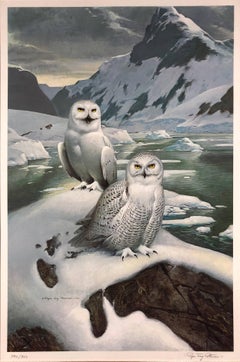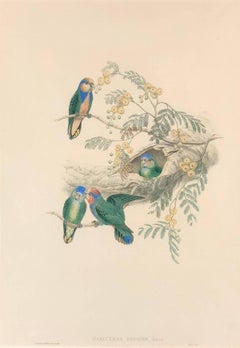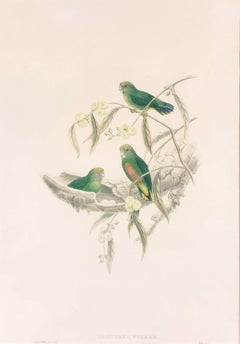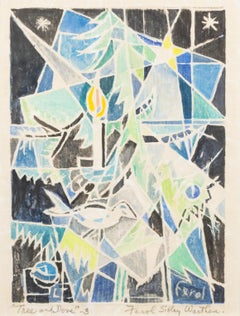Want more images or videos?
Request additional images or videos from the seller
1 of 6
Leon DanchinMallards in Flight1930s
1930s
Price:$1,125
$1,250List Price
About the Item
- Creator:Leon Danchin (1887 - 1938, French)
- Creation Year:1930s
- Dimensions:Height: 29.5 in (74.93 cm)Width: 21.5 in (54.61 cm)
- Medium:
- Movement & Style:
- Period:
- Condition:
- Gallery Location:Missouri, MO
- Reference Number:1stDibs: LU74737351822
About the Seller
5.0
Vetted Professional Seller
Every seller passes strict standards for authenticity and reliability
Established in 1970
1stDibs seller since 2017
155 sales on 1stDibs
Typical response time: Several days
Authenticity Guarantee
In the unlikely event there’s an issue with an item’s authenticity, contact us within 1 year for a full refund. DetailsMoney-Back Guarantee
If your item is not as described, is damaged in transit, or does not arrive, contact us within 7 days for a full refund. Details24-Hour Cancellation
You have a 24-hour grace period in which to reconsider your purchase, with no questions asked.Vetted Professional Sellers
Our world-class sellers must adhere to strict standards for service and quality, maintaining the integrity of our listings.Price-Match Guarantee
If you find that a seller listed the same item for a lower price elsewhere, we’ll match it.Trusted Global Delivery
Our best-in-class carrier network provides specialized shipping options worldwide, including custom delivery.You May Also Like
Tim Southall, Deer in Winter, Contemporary Etching, Animal Print, Affordable Art
By Tim Southall
Located in Deddington, GB
Tim Southall
Deer in Winter
Limited Edition Etching
Edition of 75
Image Size: H 20cm x W 30cm
Sheet Size: H 35cm x W 42cm x D 0.1cm
Sold Unframed
(Please note that in situ images are...
Category
21st Century and Contemporary Naturalistic Landscape Prints
Materials
Paper, Etching
$337
H 13.78 in W 16.54 in D 0.04 in
Owl On Branch Print Edition 92/120
By Kaiko Moti
Located in Houston, TX
Aquatint print of an owl perched on a branch with bright yellow eyes. The work is signed by the artist. It is framed in a wooden frame with a burlap matte.
Artist Biography: Kaiko M...
Category
1970s Naturalistic Animal Prints
Materials
Aquatint
Gunner Riding - Original Etching by Giovanni Fattori - 1900 ca.
By Giovanni Fattori
Located in Roma, IT
Image dimensions: 16.5x10 cm
Signed on plate by the artist.
Bibliography: A.Baboni, L’Ottocento: le incisioni di Giovanni Fattori, Museo Civico “Giovanni Fattori”, Livorno 2001, p. 7...
Category
Early 1900s Naturalistic Figurative Prints
Materials
Etching
$4,068
H 19.69 in W 13.78 in D 0.04 in
The Old Horse - Etching by Giovanni Fattori - 1900-1908 ca.
By Giovanni Fattori
Located in Roma, IT
Image dimensions: 20.2 x 15.3 cm.
The Old Horse is a superb original etching (on copper matrix) on paper, signed on plate by the Italian Macchiaioli master...
Category
Early 1900s Naturalistic Figurative Prints
Materials
Etching
$4,667
H 15.83 in W 11.3 in D 0.08 in
Horse Team - Original Etching by F. Jacque - Late 19th Century
By Frédéric Jacque
Located in Roma, IT
Horse Team is a black and white etching realized by Frederic Jacque in the late 19th Century.
The artwork represents a farmer and horses struggling with rural jobs
Good condition e...
Category
Late 19th Century Naturalistic Figurative Prints
Materials
Etching
$299
H 15.75 in W 21.26 in D 0.08 in
The Milking Girl - Original Etching by Filippo Palizzi - 1889
By Filippo Palizzi
Located in Roma, IT
The Milking Girl is an original modern artwork realized in 1889 by Filippo Palizzi.
Original Etching.
Signed and dated on plate on the lower right c...
Category
1880s Naturalistic Figurative Prints
Materials
Etching
$1,436
H 5.52 in W 8.27 in D 0.67 in
Horses - Original Etching 19th Century
Located in Roma, IT
Horses is an original etching artwork on paper realized by an Anonymous artist of the XIX century.
Hand-signed on the lower right in pencil, illegible.
The State of preservation i...
Category
19th Century Naturalistic Figurative Prints
Materials
Etching
German Wolf Trap, aquatint engraving field sport hunting print, 1813
By Samuel Howitt
Located in Melbourne, Victoria
'German Wolf Trap'
Colour aquatint by Mathew Dubourg (1786-1838) and Samuel Howitt (1756/7-1822) after Samuel Howitt (1756/7-1822).
From Samuel Howitt's 'Foreign Field Sports'. Sam...
Category
Early 19th Century Naturalistic Animal Prints
Materials
Aquatint
$140
H 7.09 in W 9.06 in
Turtle Catching on Land, aquatint engraving hunting print, 1813
By Samuel Howitt
Located in Melbourne, Victoria
'Turtle Catching on Land'
Colour aquatint by Mathew Dubourg (1786-1838) after John Heavenside Clark (c1770-1863).
From Samuel Howitt's 'Foreign Field Sports'...
Category
Early 19th Century Naturalistic Animal Prints
Materials
Aquatint
$140
H 7.09 in W 9.06 in
Shooting the Wolves in Winter, aquatint engraving hunting print, 1813
By Samuel Howitt
Located in Melbourne, Victoria
'Shooting the Wolves in Winter'
Colour aquatint by Mathew Dubourg (1786-1838) after Franz Joseph Manskirch (1768-1830).
From Samuel Howitt's 'Foreign Field Sports'. Samuel Howitt w...
Category
Early 19th Century Naturalistic Animal Prints
Materials
Aquatint
$140
H 7.09 in W 9.06 in
More From This Seller
View AllTwo Snowy Owls
By Roger Tory Peterson
Located in Missouri, MO
Color Lithograph
Image Size: 30 x 19 inches
Framed Size: 40.25 x 29.75 inches
Edition 392/950
Artist Signed and Numbered
Artist and naturalist Roger Tory Peterson...
Category
Late 20th Century Naturalistic Animal Prints
Materials
Lithograph
Price Upon Request
Nasiterna Bruijni
By John Gould
Located in Missouri, MO
John Gould (British, 1804-1881)
Nasiterna Bruijni c. 1849-1861
Hand Colored Lithograph
Image Size: approx 19.5 x 13.5 inches
Framed Size: 27 3/8 x 21 1/2 inches
John Gould was an English ornithologist and bird artist. The Gould League in Australia was named after him. His identification of the birds now nicknamed "Darwin's finches" played a role in the inception of Darwin's theory of evolution by natural selection. Gould's work is referenced in Charles Darwin's book, On the Origin of Species.
Gould was born in Lyme Regis, Dorset, the son of a gardener, and the boy probably had a scanty education. Shortly afterwards his father obtained a position on an estate near Guildford, Surrey, and then in 1818 became foreman in the Royal Gardens of Windsor. He was for some time under the care of J T Aiton, of the Royal Gardens of Windsor. The young Gould started training as a gardener, being employed under his father at Windsor from 1818 to 1824, and he was subsequently a gardener at Ripley Castle in Yorkshire. He became an expert in the art of taxidermy, and in 1824 he set himself up in business in London as a taxidermist, and his skill led to him becoming the first Curator and Preserver at the museum of the Zoological Society of London in 1827.
Gould's position brought him into contact with the country's leading naturalists, and also meant that he was often the first to see new collections of birds given to the Society. In 1830 a collection of birds arrived from the Himalayas, many not previously described. Gould published these birds in A Century of Birds from the Himalaya Mountains (1830-1832). The text was by Nicholas Aylward Vigors, and the illustrations were lithographed by Gould's wife Elizabeth, daughter of Nicholas Coxen of Kent.
This work was followed by four more in the next seven years including Birds of Europe in five volumes - completed in 1837, with the text written by Gould himself, edited by his clerk Edwin Prince. Some of the illustrations were made by Edward Lear as part of his Illustrations of the Family of Psittacidae in 1832. Lear however was in financial difficulty, and he sold the entire set of lithographs to Gould. The books were published in a very large size, imperial folio, with magnificent coloured plates. Eventually 41 of these volumes were published with about 3000 plates. They appeared in parts at £3 3s. a number, subscribed for in advance, and in spite of the heavy expense of preparing the plates, Gould succeeded in making his ventures pay and in realizing a fortune. In 1838 he and his wife moved to Australia to work on the Birds of Australia and shortly after his return to England, his wife died in 1841.
When Charles Darwin presented his mammal and bird specimens collected during the second voyage of HMS Beagle to the Geological Society of London at their meeting on 4 January 1837, the bird specimens were given to Gould for identification. He set aside his paying work and at the next meeting on 10 January reported that birds from the Galápagos Islands, which Darwin had thought were blackbirds, "gross-bills" and finches were in fact "a series of ground Finches which are so peculiar" as to form "an entirely new group, containing 12 species." This story made the newspapers.
In March, Darwin met Gould again, learning that his Galápagos "wren" was another species of finch and the mockingbirds he had labeled by island were separate species rather than just varieties, with relatives on the South American mainland. Subsequently Gould advised that the smaller southern Rhea specimen that had been rescued from a Christmas dinner...
Category
1850s Naturalistic Animal Prints
Materials
Lithograph
Nasiterna Pygmae
By John Gould
Located in Missouri, MO
John Gould (British, 1804-1881)
Nasiterna Pygmae c. 1849-1861
Hand Colored Lithograph
Image Size: approx 19.5 x 13.5 inches
Framed Size: 27 3/8 x 21 1/2 inches
John Gould was an English ornithologist and bird artist. The Gould League in Australia was named after him. His identification of the birds now nicknamed "Darwin's finches" played a role in the inception of Darwin's theory of evolution by natural selection. Gould's work is referenced in Charles Darwin's book, On the Origin of Species.
Gould was born in Lyme Regis, Dorset, the son of a gardener, and the boy probably had a scanty education. Shortly afterwards his father obtained a position on an estate near Guildford, Surrey, and then in 1818 became foreman in the Royal Gardens of Windsor. He was for some time under the care of J T Aiton, of the Royal Gardens of Windsor. The young Gould started training as a gardener, being employed under his father at Windsor from 1818 to 1824, and he was subsequently a gardener at Ripley Castle in Yorkshire. He became an expert in the art of taxidermy, and in 1824 he set himself up in business in London as a taxidermist, and his skill led to him becoming the first Curator and Preserver at the museum of the Zoological Society of London in 1827.
Gould's position brought him into contact with the country's leading naturalists, and also meant that he was often the first to see new collections of birds given to the Society. In 1830 a collection of birds arrived from the Himalayas, many not previously described. Gould published these birds in A Century of Birds from the Himalaya Mountains (1830-1832). The text was by Nicholas Aylward Vigors, and the illustrations were lithographed by Gould's wife Elizabeth, daughter of Nicholas Coxen of Kent.
This work was followed by four more in the next seven years including Birds of Europe in five volumes - completed in 1837, with the text written by Gould himself, edited by his clerk Edwin Prince. Some of the illustrations were made by Edward Lear as part of his Illustrations of the Family of Psittacidae in 1832. Lear however was in financial difficulty, and he sold the entire set of lithographs to Gould. The books were published in a very large size, imperial folio, with magnificent coloured plates. Eventually 41 of these volumes were published with about 3000 plates. They appeared in parts at £3 3s. a number, subscribed for in advance, and in spite of the heavy expense of preparing the plates, Gould succeeded in making his ventures pay and in realizing a fortune. In 1838 he and his wife moved to Australia to work on the Birds of Australia and shortly after his return to England, his wife died in 1841.
When Charles Darwin presented his mammal and bird specimens collected during the second voyage of HMS Beagle to the Geological Society of London at their meeting on 4 January 1837, the bird specimens were given to Gould for identification. He set aside his paying work and at the next meeting on 10 January reported that birds from the Galápagos Islands, which Darwin had thought were blackbirds, "gross-bills" and finches were in fact "a series of ground Finches which are so peculiar" as to form "an entirely new group, containing 12 species." This story made the newspapers.
In March, Darwin met Gould again, learning that his Galápagos "wren" was another species of finch and the mockingbirds he had labeled by island were separate species rather than just varieties, with relatives on the South American mainland. Subsequently Gould advised that the smaller southern Rhea specimen that had been rescued from a Christmas dinner...
Category
Mid-19th Century Naturalistic Animal Prints
Materials
Lithograph
Tree and Dove
Located in Missouri, MO
Tree and Dove
Ferol K. Sibley Warthen (American, 1890-1986)
Color Woodblock Print
Edition of 3
6.25 x 4.75 inches
13 x 11.5 inches with frame
Signed Lower Right
Titled Lower Left
Born 1890, Died 1986...
Category
Mid-20th Century American Modern Animal Prints
Materials
Color
Les Poissons
By Zao Wou-Ki
Located in Missouri, MO
Zao Wou-Ki (Chinese, French, 1921-2013)
Les Poissons, 1953
Lithograph
Hand-signed in pencil Lower Right
Hand-numbered 16/55 in pencil Lower Left
18 x 23 1/8 inches
29 x 33 inches wit...
Category
1950s Modern Animal Prints
Materials
Lithograph
$12,500
Bird's Eye View
By Ronnie Cutrone
Located in Missouri, MO
Ronnie Cutrone (1948-2013)
"Bird's Eye View" c. 1980s
Color Lithograph
Ed. 222/250
Signed, Numbered and Titled
Image Size: 17 x 23.5 inches
Framed Size: approx. 24 x 30 inches.
Ronnie Cutrone, a figurehead of the Pop and Post-Pop art scenes, was Andy Warhol's assistant at the Factory atop the Decker Building from 1972-1980, and worked closely with Roy Lichtenstein, combining stylistic elements of both. Cutrone's large-scale paintings of American cartoon icons, like Mickey Mouse, Felix the Cat, and Woody Woodpecker further reinvented kitsch and popular media in terms of fine art.
Executed in fluorescent monochromatic colors with the finesse of mass-produced silkscreen and prints, Cutrone's works are the reverse of tromp-l'oeil; they use fine art media (watercolor, pastel, crayon - on high-quality paper) to celebrate, rather than hide, the artifice of their subjects. "Everything is cartoon for me", Cutrone is noted for saying, even "ancient manuscripts...
Category
Late 20th Century Pop Art Figurative Prints
Materials
Lithograph
Price Upon Request
Recently Viewed
View AllMore Ways To Browse
Mallard Prints
Mallards In Flight
Damien Hirst The Souls
David Hockney Boodge
Francisco Toledo Etching
George Rodrigue Texas
George Rodrigue Tie
George Rodrigue Top Dog
George Studdy
Hans Kleiber
Horse Hunting Prints
Johann Leonhard Frisch
Kip Gresham
Larry Rivers Camel
Leroy Neiman Elephant
Lloyd Kiva
Lobster Telephone
Norbertine Bresslern Roth



